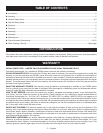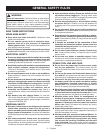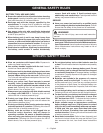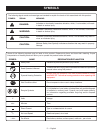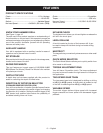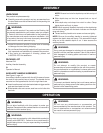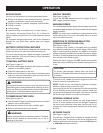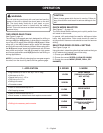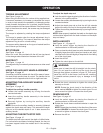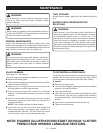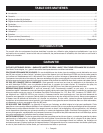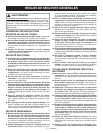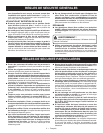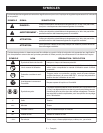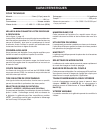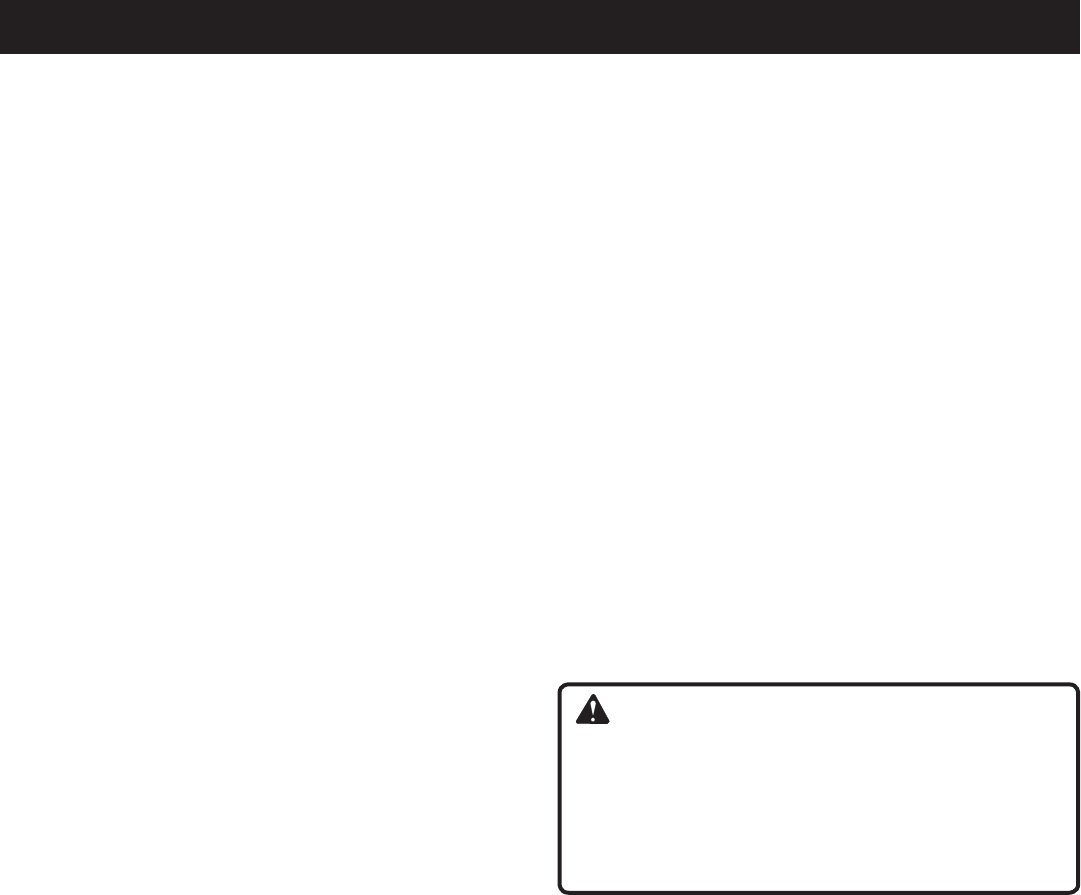
10 — English
To adjust the depth stop rod:
Lock the switch trigger by placing the direction of rotation
selector in the center position.
Loosen the auxiliary handle assembly by turning the knob
counterclockwise.
Adjust the depth stop rod so that the drill bit extends
beyond the end of the rod to the required drilling depth.
Tighten the auxiliary handle assembly by turning the knob
clockwise.
NOTE: When properly installed, the teeth on the depth stop
rod should be aligned with the teeth indicator on the depth
stop rod clamp.
INSTALLING BITS
See Figures 14 - 15, page 15.
Lock the switch trigger by placing the direction of
rotation selector in the center position.
Open or close the chuck jaws to a point where the opening
is slightly larger than the bit size you intend to use. Also,
raise the front of the drill slightly to keep the bit from falling
out of the chuck jaws.
Insert the drill bit.
Tighten the chuck jaws on the drill bit.
WARNING:
Make sure to insert the drill bit straight into the chuck
jaws. Do not insert the drill bit into the chuck jaws at
an angle then tighten, as shown in figure 15. This could
cause the drill bit to be thrown from the drill, resulting
in possible serious personal injury or damage to the
chuck.
Rotate the chuck clockwise to tighten the chuck jaws
securely on the bit.
NOTE: Rotate the chuck body in the direction of the
arrow marked LOCK to tighten the chuck jaws. Do not
use a wrench to tighten or loosen the chuck jaws.
REMOVING BITS
See Figure 14, page 15.
Lock the switch trigger by placing the direction of
rotation selector in the center position.
Rotate the chuck sleeve counterclockwise to open the
chuck jaws.
NOTE: Rotate the chuck body in the direction of the arrow
marked UNLOCK to loosen the chuck jaws. Do not use
a wrench to tighten or loosen the chuck jaws.
Remove the drill bit.
OPERATION
TORQUE ADJUSTMENT
See Figure 9, page 14.
When using the drill-driver for various driving applications,
it becomes necessary to increase or decrease the torque
in order to help prevent the possibility of damaging screw
heads, threads, workpiece, etc. In general, torque intensity
should correspond to the screw diameter. If the torque is too
high or the screws too small, the screws may be damaged
or broken.
The torque is adjusted by rotating the torque adjustment
ring.
The torque is greater when the torque adjustment ring is
set on a higher setting. The torque is less when the torque
adjustment ring is set on a lower setting.
The proper setting depends on the type of material and the
size of screw you are using.
BIT STORAGE
See Figure 10, page 14.
When not in use, bits provided with the drill can be placed
in the storage areas located on the base of the drill.
MAGTRAY™
See Figure 11, page 14.
The magnetic tray conveniently stores screws or other small
parts.
USING THE AUXILIARY HANDLE ASSEMBLY
See Figure 12, page 15.
An auxiliary handle is packed with the drill for ease of opera-
tion and to help prevent loss of control. The handle can be
mounted on the opposite side for left or right hand use.
ADJUSTING THE AUXILIARY HANDLE
ASSEMBLY
See Figure 12, page 15.
To adjust the auxiliary handle assembly:
Loosen the handle assembly by turning the handle
counterclockwise.
Insert the auxiliary handle assembly in the desired
operating position.
Securely tighten by turning the auxiliary handle
clockwise.
NOTE: Be sure the auxiliary handle is securely tightened
against the depth stop rod clamp. This secures the depth
stop rod at the desired depth of cut. It also secures the
auxiliary handle.
ADJUSTING THE DEPTH STOP ROD
See Figure 13, page 15.
The depth stop rod helps control the depth of drilled holes.
For convenience and ease of starting threads, the hex nut
has been trapped inside the molded slot in the auxiliary
handle.



